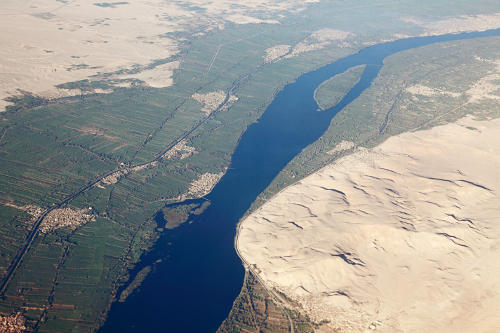Using AI to control energy for indoor agriculture
30 September 2024
Published online 15 May 2017
Climate change will up Nile flow variability, but to exploit flood periods, more water storage is needed.

© Image Source / Alamy Stock Photo
A new study into the river's flow has been undertaken by researchers at the Massachusetts Institute of Technology (MIT). Breene M. Kerr, professor of hydrology and climate, Elfatih Eltahir, professor of civil and environmental engineering, and Mohamed Siam, a postdoctoral associate, have revealed that climate change will mean greater variability in the Nile River flow in the next century compared to the last; with more extreme droughts and heavier floods.
“Until this paper, we didn’t know what will happen to the Nile due to climate change,” Eltahir tells Nature Middle East. “What this paper emphasizes is not whether we are going to have more or less water; but that whatever we get in the future is going to happen with more fluctuations; more years of above-average flood and more […] droughts.”
Over six years the MIT researchers analyzed data and looked at climate models to reach this conclusion.
“Part of our work is based on climate models and part is based on observations to see whether the same trends exist,” explains Siam. “So we did that for the past 140 years looking for a trend similar to the one we will see in the next 100 years.”
There will be, however, an overall average increase of the Nile’s annual flow from the current 80 cubic kilometers per year to around 92 cubic kilometers — about 10 to 15 percent increase over the last century. It’s equivalent to the amount of water that evaporates from Lake Nasser, “which is significant,” according to Eltahir.
The countries benefiting most from this increase, Siam explains, are the eastern Nile basin countries; mainly Egypt, Ethiopia and Sudan.
The study, published in Nature Climate Change, is based on the observed effect of El Niño/La Niña cycles in the Pacific Ocean, which have become more intense and more frequent as a result of global warming. Previous research Eltahir had conducted found that this phenomenon is strongly related to the annual rainfall variations in the Ethiopian highlands and adjacent eastern Nile basins; an area representing 80 percent of the river’s waters.
The researchers say that the findings of their study can help governments and scientists plan for short-term water resource management.
Siam and Eltahir, however, also insist that if Nile basin countries wish to make use of this average increase to ease the hardships of the predicted extreme drought years, they will need more reservoirs and storage capacity.
Generally, an increase in water supplies is positive, says Siam. “But if we can’t manage this increase, then we won’t make use of it.”
In light of the new information, Nile basin countries would need around 55% additional storage capacity to maintain existing levels of reliability. “I am not arguing that people should go and build dams,” says Eltahir. “The reality is that we are going to have more variability and a little more water, the only feasible thing to do is to have additional storage.”
Besides climate change, the Nile basin countries face another problem: a population boom. “The population increases and we divide the same amount of water on them, which means that each individual’s portion decreases,” says Siam. “So yes, we will have more water, but the population growth is far higher.”
Siam argues that controlling population is key, but the ultimate goal should be better integration between Nile basin countries when it comes to water management. “Ethiopia has water, Sudan has land, Egypt imports a big portion of its food and has the technology of agriculture,” Siam says. They should work together, says the scientist.
doi:10.1038/nmiddleeast.2017.84
Stay connected: